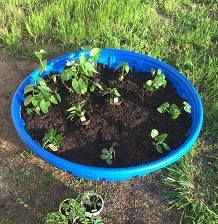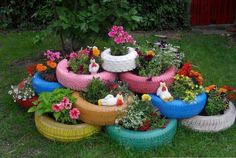By Susan Enzweiler
My friend asked me, “Have you ever planted a ‘hillbilly’ garden?”
We were discussing gardening in pots and how I wished I had a bigger space for herbs. At the time, creating a raised bed was too expensive and labor intensive for me.
It turns out that a ‘hillbilly’ garden was the perfect solution. The container for such a garden is a plastic swimming pool for toddlers. Just drill holes in the bottom of it for drainage, fill it with a growing medium and add your herbs. It’s not the most attractive container. Maybe something only a hillbilly would consider using, but I’m originally from Kentucky so that’s OK with me.
Container gardening can be strictly utilitarian (like herbs in a kiddie pool) or an artistic endeavor where the type of container and its colorful riot of plants creates a living, outdoor floral arrangement.
The container must drain well and hold enough medium for the plants to reach maturity. Holes in the bottom of the pot along with added gravel or Styrofoam peanuts allow for good drainage. Also place the container up on supports or in a saucer.
Select a medium that drains well and retains moisture. Container gardens must never dry out. A soilless media is the best choice. It also harbors no pests, weed seeds or pathogens. You can purchase such media from garden centers, but avoid those that contain only peat or peat lite. You can develop your own by combining peat moss, vermiculite or perlite, sterile potting mix and coarse sand. Figure out how much lime you may need to add by sending a sample of your mix to a soil testing laboratory. (To obtain information on a soil testing kit, call the Montgomery County Extension Office 334-270-4133 or email capcitymga@gmail.com)
If your container garden holds a variety of plants, they all must share the same sunlight/shade and water requirements to remain healthy. The plant combination should balance colors and textures, heights and shapes for the most dramatic effect. Don’t be afraid to mix vegetables and herbs with flowers and vines. Companion planting is not only attractive but also helps prevent disease and pest infestations.
Choose healthy plants and seeds that are both disease- and pest-free. Give them the room they need to grow. In the case of seedlings, this will require thinning them back. Fertilize your container garden with a slow-release fertilizer. If needed, supplement with a water-soluble fertilizer throughout the growing season.
Watering is the most crucial and time-consuming aspect of container gardening. As the plants mature and their roots fill the container, they will need plenty of water. Container gardens in full sun should be watered deeply every few days. During our hot summers, mature plants may need watering once or even twice a day. Using a drip irrigation system with an automatic timer and adding water-holding polymers or gels to your planting media will make your watering task easier.
I enjoyed fresh herbs from my ‘hillbilly’ garden all summer long. Whether they’re pretty or plain, your container gardens will provide you plenty of enjoyment and maybe even some edibles!
Susan Enzweiler, an Intern in the 2016 Master Gardener Class, lives in Montgomery. For more information on becoming a master gardener, visit www.capcitymga.org or email capcitymga@gmail.com.
 Part of the Alabama Cooperative Extension Service (ACES)
Part of the Alabama Cooperative Extension Service (ACES)

